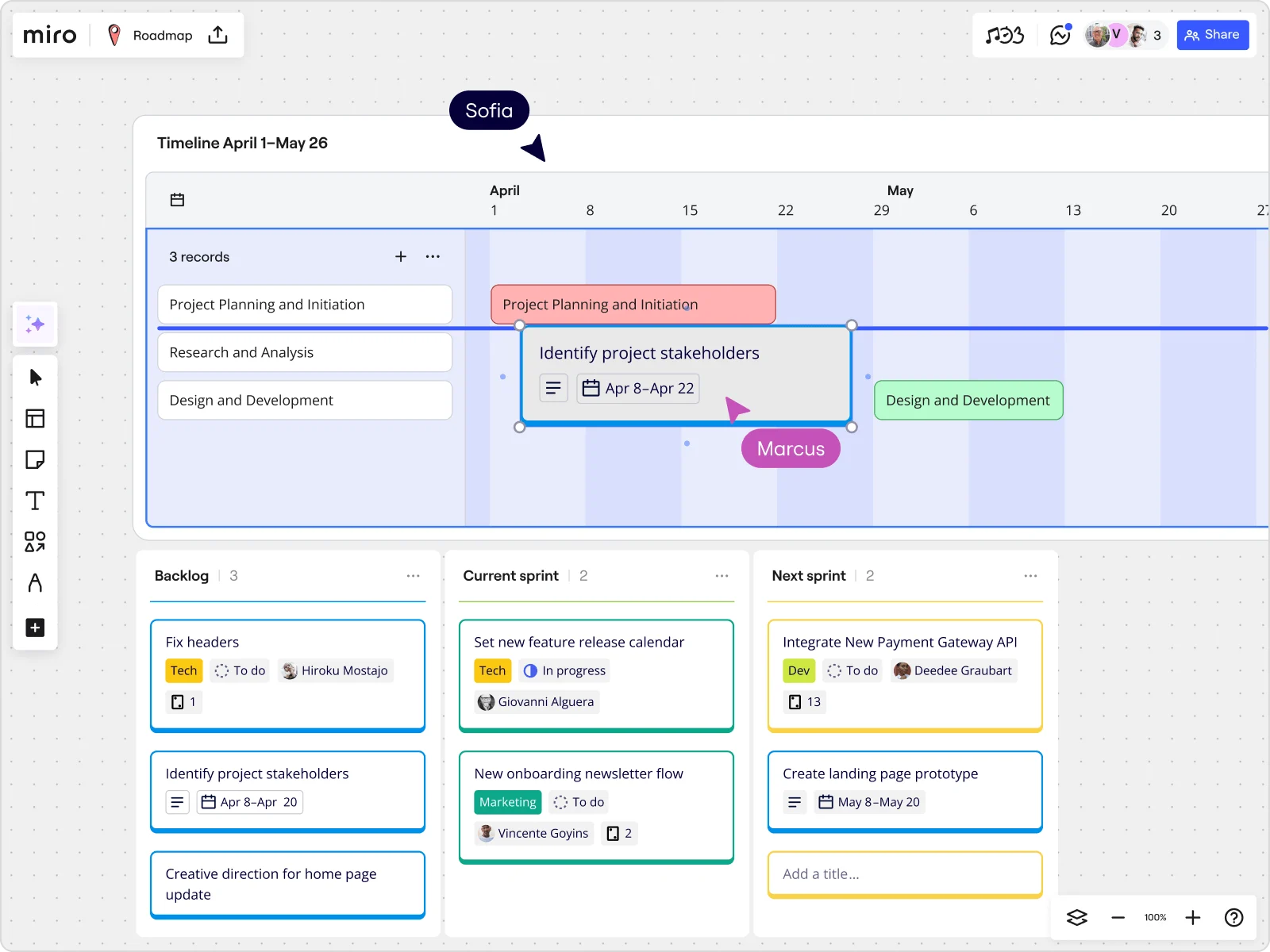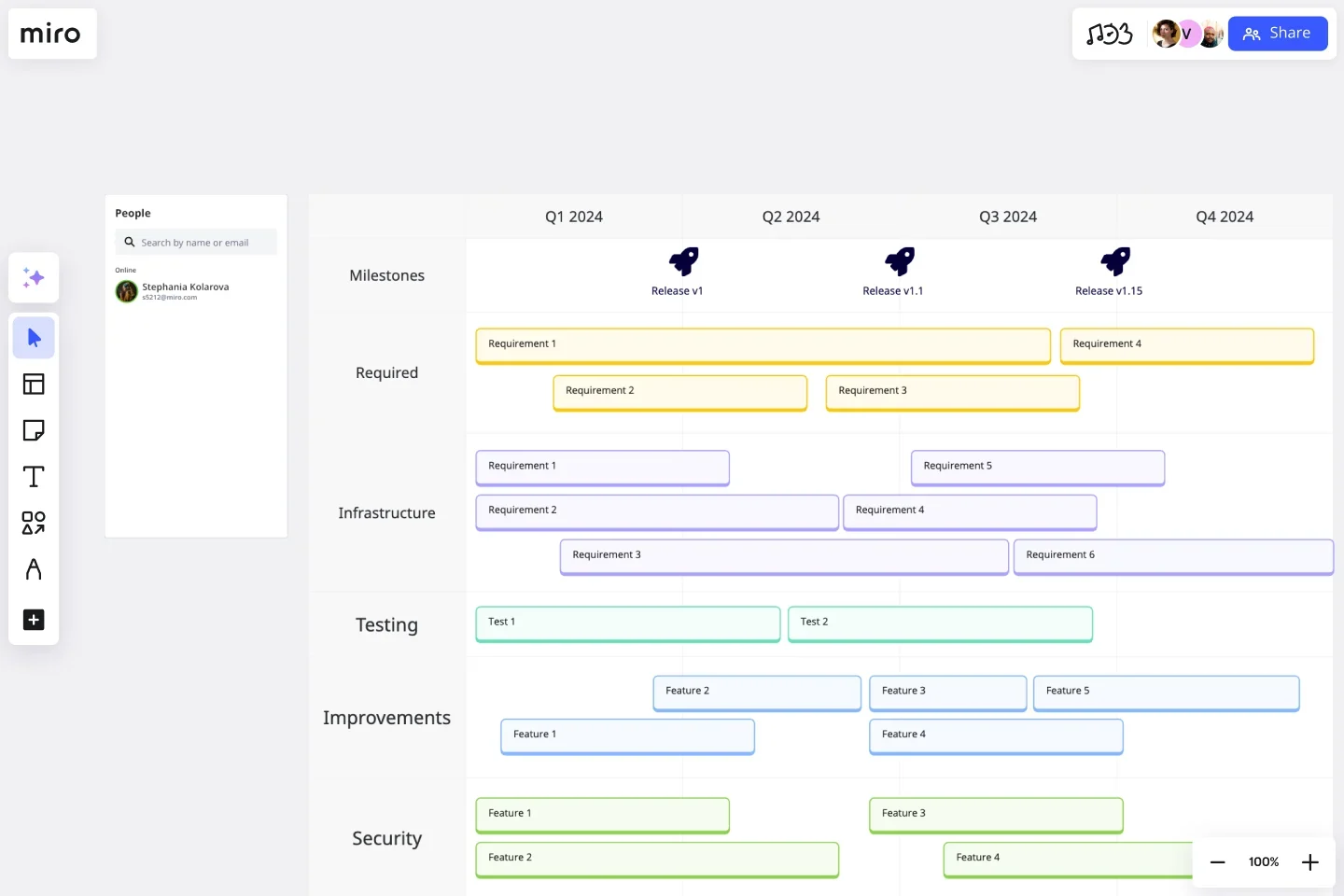
Technology roadmap examples — and how to build your own

Summary
In this guide, you will learn:
How Miro's technology roadmap templates help Agile teams visualize strategy, plan, and collaborate
Key steps to build a technology roadmap: define themes, break down initiatives, set flexible time horizons, map dependencies, track progress, and enable collaboration
The importance of organizing initiatives into short-, mid-, and long-term phases for strategic direction and adaptability
How to use visual markers and real-time updates to monitor progress and inform stakeholders
Ways to customize templates with project goals, milestones, timelines, and team responsibilities
How Miro's collaborative features support asynchronous and real-time teamwork, feedback, and roadmap refinement
Try Miro now
Join thousands of teams using Miro to do their best work yet.
A technology roadmap is essential for planning and aligning technical initiatives with your organization’s strategic goals. Whether you’re introducing new systems, improving infrastructure, or rolling out innovations, a well-structured roadmap keeps your team on track.
In this guide, we’ll not only explain what a technology roadmap is — but we’ll also explore its types, and provide practical examples to help you create your own.
What is a technology roadmap?
A technology roadmap is a visual document that outlines an organization’s plans for adopting and implementing technology over time. It helps teams understand the priorities, timelines, and resources required to achieve technical objectives. By offering clarity and alignment, technology roadmaps ensure that initiatives remain focused on the organization’s broader goals.
Types of technology roadmaps
Not all roadmaps are the same. Different businesses require different approaches based on their goals. Here are the most common types — we'll dive deeper into each one in the next section:
Infrastructure roadmaps
These roadmaps focus on upgrades or changes to an organization’s IT infrastructure, such as server upgrades, cloud migrations, or data center consolidations.
Product development roadmaps
Product-focused roadmaps align technical features and updates with broader product strategies, helping teams stay on track with releases.
Innovation roadmaps
These emphasize future-focused initiatives like adopting new technologies, exploring artificial intelligence, or scaling machine learning capabilities.
Process improvement roadmaps
These roadmaps highlight opportunities for streamlining workflows, automating manual processes, or improving operational efficiency through technology.

5 technology roadmap examples
Here are technical roadmap sample formats tailored for various business needs. Each one demonstrates a different use case, offering inspiration for your next project.
Example 1: Infrastructure upgrade roadmap
This roadmap focuses on optimizing current IT infrastructure. It typically includes phases like assessment, procurement, and implementation.
Phase 1: Assess existing systems to identify bottlenecks and improvement areas.
Phase 2: Prioritize infrastructure upgrades like servers, storage, and network systems.
Phase 3: Implement upgrades and ensure proper testing to minimize downtime.
Example 2: Product launch roadmap
A roadmap designed to align technical development with product milestones and releases.
Milestone 1: Define product requirements and finalize technical specifications.
Milestone 2: Begin development of key features and integrate with existing systems.
Milestone 3: Conduct rigorous testing before deploying the final product.
Example 3: Digital transformation roadmap
Focused on adopting new technologies to drive innovation and improve business operations.
Step 1: Identify key areas where technology can drive efficiency or new opportunities.
Step 2: Establish a phased timeline for adopting tools like cloud platforms or CRM software.
Step 3: Train staff and ensure company-wide adoption of the new technology stack.
Example 4: Innovation roadmap
Ideal for organizations aiming to stay competitive through emerging technologies.
Objective 1: Evaluate the potential benefits of tools like AI, blockchain, or IoT.
Objective 2: Run pilot programs to test the feasibility of new technologies.
Objective 3: Scale successful innovations across the organization.
Example 5: Process optimization roadmap
Designed to streamline existing workflows and increase operational efficiency.
Goal 1: Map current processes to identify inefficiencies.
Goal 2: Implement automation tools or process reengineering strategies.
Goal 3: Measure outcomes and iterate for continuous improvement.
How to create a technology roadmap
Building a roadmap requires careful planning and alignment across teams. Follow these steps:
Define strategic objectives
Start by clearly identifying what you aim to achieve with your roadmap. Are you improving internal processes, launching a new product, or driving innovation?
Assess current state
Evaluate your existing technologies, resources, and capabilities. Understanding where you are today helps identify gaps and opportunities.
Gather stakeholder input
Collaborate with key stakeholders, including leadership, technical teams, and end-users. Their insights ensure the roadmap reflects practical needs and priorities.
Prioritize initiatives
Not all initiatives can be tackled at once. Rank your projects based on urgency, impact, and feasibility to focus on what matters most.
Allocate resources and manage risks
Ensure you have the right people, budget, and tools to execute your roadmap. Identify potential risks and develop strategies to mitigate them.
Monitor progress
Set measurable goals and track your progress regularly. Adjust timelines or reallocate resources as needed to stay aligned with your objectives.

Best practices for creating technology roadmaps
Follow these best practices to ensure your roadmap delivers results:
Align with business goals
Your technology roadmap should directly support your organization’s strategic objectives. Ensure that every initiative contributes to measurable outcomes.
Keep it visual
Use tools like Gantt charts or timeline-based roadmaps to make complex plans easy to understand. A clear technology roadmap format fosters better communication and alignment.
Stay flexible
Technology evolves rapidly. Design your roadmap to adapt to changing priorities, new tools, or unforeseen challenges.
Foster collaboration
Involve stakeholders from the beginning. Their buy-in ensures your roadmap is both actionable and impactful.
Build a technology roadmap in Miro
Crafting a roadmap doesn’t have to be complicated. Miro’s innovation workspace offers an AI-powered visual canvas that helps teams create, collaborate, and execute plans effectively. With customizable templates for technology roadmapping, Miro simplifies every step of the process.
Sign up to get started.
Author: Miro Team
Last update: October 2, 2025